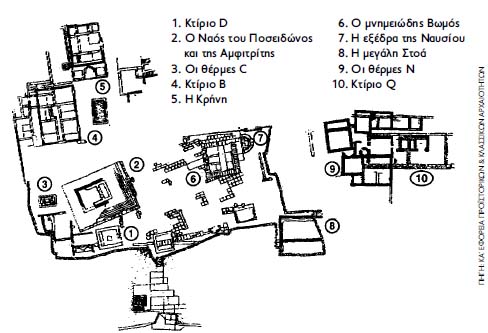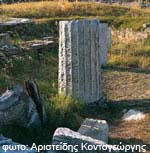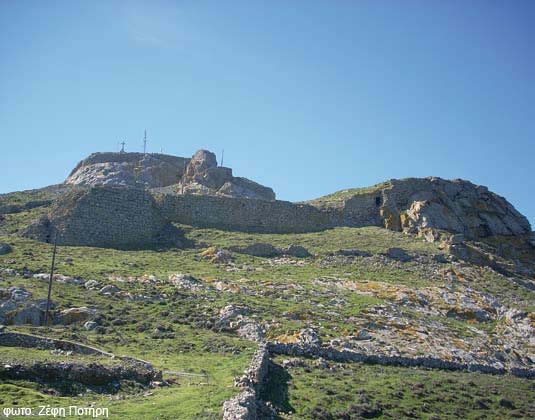
"KIONIA"
 "Kionia" is considered as one of the most important places of worship of the ancient Greeks, coinciding with the foundation and prosperity of the ancient "Town" of Tinos, from the 4th century BC and on. It comprises the only place in the Cyclades that is exclusively dedicated to Poseidon, the sea-god. According to archaeological sources, during ancient times, the god was worshiped equally as a doctor. Furthermore, there is documentation about an increasing adoration concerning doctors, who were considered as heroes. At the end of the 4th century BC, the successors of Alexander the Great and mainly the royal families named Antigonides and Lagides, hold the fate of the Cyclades in their hands and organize building programs, in which the Sanctuary of Poseidon in Kionia might have been included. A proof of the sanctuary´s influence might be the eight-ray star that decorates the panel of the roof of the drinking fountain, a beloved theme in Macedonia, found in the tomb of King Philip, as well.
"Kionia" is considered as one of the most important places of worship of the ancient Greeks, coinciding with the foundation and prosperity of the ancient "Town" of Tinos, from the 4th century BC and on. It comprises the only place in the Cyclades that is exclusively dedicated to Poseidon, the sea-god. According to archaeological sources, during ancient times, the god was worshiped equally as a doctor. Furthermore, there is documentation about an increasing adoration concerning doctors, who were considered as heroes. At the end of the 4th century BC, the successors of Alexander the Great and mainly the royal families named Antigonides and Lagides, hold the fate of the Cyclades in their hands and organize building programs, in which the Sanctuary of Poseidon in Kionia might have been included. A proof of the sanctuary´s influence might be the eight-ray star that decorates the panel of the roof of the drinking fountain, a beloved theme in Macedonia, found in the tomb of King Philip, as well.

Some evidence of pre-historical presence was found in the western area of the Sanctuary, without evidence of any continuity. It is confirmed that the sanctuary was founded in the middle of the 4th century BC, when the first signs of worship in the area are dated. Under the same period, the borough and the administration headquarters were transferred from "Xomburgo" to the present town of Tinos, while at the end of the same century, the first monumental buildings appear in the area of "Kionia".
Before its foundation, another Sanctuary existed there already, built inside a garden. It is said that sailors and travelers prayed there to placate the sea god and have a good voyage on their way to the sacred island of nearby Delos, the destination of their pilgrimage. The reconstruction of the famous temple of Poseidon and Amphitrite, as we mentioned above, is dated to the middle of the 4th century BC. Its order is Doric, rigorous and simple, except for an original touch, like the drinking fountain-platform, owed to the Tinian inspiration. The building materials used are entirely local and among them are found gneiss and marble in different colors. Sculptors from several places were invited to decorate the Sanctuary, such as Telesinos from Athens, Agasias from Ephesus, while the Macedonian Andronicus from "Kyristos" constructed a great solar clock (it is now in the island's archeological museum). The building program of the end of the 2nd century BC, which included imposing buildings like the great arcade and the monumental altar, coincides with the big economic growth of the Cyclades, when Delos became a free port and many foreigners, mainly Italians, settled down there. Limited building activity is detected during the Roman rule, after a period of decline.
By the middle of the 1st century BC, though, the old splendor vanishes and, in the middle of the 3rd century AC, the Sanctuary is abandoned. The problems of the Roman Empire, in addition to the invasions of the “Erouls”, that destroyed Athens in 267/8 AC, put an end to a history of six centuries. A ceramic oven operated for a while, amidst the ruins. It seems that the Sanctuary was only a wreck, where only those who sought ready-to-use building material hang around, in order to use it elsewhere.
 The Temple’s fame can be confirmed by the historian “Strabo”, referring to it as "massive and worth seeing", but also from the wide range of its fame, that exceeded the borders of the Greek world and reached Italy and Asia Minor. In this Sanctuary, festivals were also organized in honor of the god, the well known "Poseidonia" and "Poseidia" (in January-February). Many people came from all over Greece, theatrical competitions took place and lamb sacrifices were made. On account of some descriptions and excavations of the Temple, we learn that the statues of Poseidon and Amphitrite were placed in the Sanctuary. Under the same period, the worship of Amphitrite, Poseidon's wife, was also established. She was worshiped for her curative powers applied to women who couldn't conceive. This Sanctuary had a healing fame, equal to that of Asclepius in Epidaurus, so ailing people wishing to be cured visited it, trusting its beneficial powers. Furthermore it's a fact that the environment where it was built -in a garden by the sea- favored their cure. The temple priests, in addition to their other tasks, performed operations on the patients, as well. The worship of this Sanctuary lasted until the 4th century AC, when Christianity, the new religion, was established and the Greek Dodecatheon was renounced. After the end of the Sanctuary's worship, many of its building elements were used by locals for house and church constructions. The gardens were used as well, for banquettes.
The Temple’s fame can be confirmed by the historian “Strabo”, referring to it as "massive and worth seeing", but also from the wide range of its fame, that exceeded the borders of the Greek world and reached Italy and Asia Minor. In this Sanctuary, festivals were also organized in honor of the god, the well known "Poseidonia" and "Poseidia" (in January-February). Many people came from all over Greece, theatrical competitions took place and lamb sacrifices were made. On account of some descriptions and excavations of the Temple, we learn that the statues of Poseidon and Amphitrite were placed in the Sanctuary. Under the same period, the worship of Amphitrite, Poseidon's wife, was also established. She was worshiped for her curative powers applied to women who couldn't conceive. This Sanctuary had a healing fame, equal to that of Asclepius in Epidaurus, so ailing people wishing to be cured visited it, trusting its beneficial powers. Furthermore it's a fact that the environment where it was built -in a garden by the sea- favored their cure. The temple priests, in addition to their other tasks, performed operations on the patients, as well. The worship of this Sanctuary lasted until the 4th century AC, when Christianity, the new religion, was established and the Greek Dodecatheon was renounced. After the end of the Sanctuary's worship, many of its building elements were used by locals for house and church constructions. The gardens were used as well, for banquettes.
The final destruction of the Temple happened during the Venetian and Turkish eras, when the captors took advantage of everything that had remained at the place, i.e. statues, columns and other parts, for constructing churches and other buildings.
From the excavations of the Belgian archeologists H. Demoulin and P. Graindor in the beginning of last century, (1903 and 1905) the remains of the Temple, the drinking fountain, the statues, the mosaics and the Andronicus famous solar-clock were discovered. Some of these findings are currently exhibited at the Archeological museum of Tinos.
XOMBURGO

The rock of Xomburgo is located at a height of 640 m and dominates the middle of the southern part of the island. It is a landmark of Tinos, welcoming visitors when the boat reaches the port of "Chora". It is directly connected to the lives and safety of the inhabitants, due to its natural entrenchment.
Its history starts from the ancient years, but we will only refer to the evidences found by documentation and excavations. The first signs of human settlement go back to the Copper period, when the Cyclopean wall is built in Xomburgo. This fact indicates that until then, the previous main settlement in the area "Vriocastro" ceased being safe, probably due to invasions from the sea. Consequently its inhabitants are forced to seek a safer shelter.
Dwelling on this rocky hill continues through the Dark Ages and the Geometric period. The cemetery outside the walls, which came into light by the Professor of Archaeology Mrs Nota Kourou, is a common phenomenon, during that period of time. The fire-holes in the area are dated to the same period (10th-7th century BC), while the Sanctuary of the Great Goddess and Daughter, is being traced back to the archaic period. Its worship was subject to the cultural conditions of that era and the Dodecatheon (twelve-god) cult. The Temple was dedicated to goddess Dimitra (Ceres) and her daughter, Persephone. 
The safety and peace that prevailed in the Aegean Sea during the Classic years, gave the opportunity to the island inhabitants to abandon Xomburgo and found a coastal city. The rock will lapse into obscurity until the Byzantine years, when it will be inhabited once more, reaching its climax. Incursions and continuous invasions made local inhabitants within and around the granite rock reunite, establishing a capital in the area of the present village of "Xynara".
In 1207, the brothers Andreas and Jeremiah Ghizi captured Tinos. One of their first moves was to erect fortifications and entrench the rock, making it a stronghold. The "Castle of Saint Helen" as it was called, took its name from the homonymous chapel on its peak. Until the last offspring of the Ghizi family in 1390, the castle of Tinos was famous for its entrenchment and the safety that provided to the people. The Ghizis’ rule was followed by the Venetian Democracy and, after the locals made a pact not to subjugate themselves to the Turkish dominance, a Commander was appointed bearing the title of "Rector of Tinos and Mykonos". In 1537, Hayreddin Barbarossa conquered Tinos, for the behalf of the Sultan. Tinos rose in revolt, asking the Venetians back. This way “La Serenissima,” retrieved the island, which was the Venetians’ only dominion left in the Cyclades. The fortress was rebuilt to become stronger than ever and, according to the building conditions prevailing during the 16th century AC, the NE-SE side of the rock was used as a natural fortification. Consequently, only the sides of the castle needed backing, where the town was built. The documentation reveals that there were about 100 buildings, houses and stores, as well as two churches in Borgo (thorp outside the castle). Most inhabitants were occupied with agriculture, as  the castle comprised, apart from a shelter, also the main market of the island.
the castle comprised, apart from a shelter, also the main market of the island.
The 600 m long wall included: a high tower named Tower A, or the "half moon" at the SE side, the main entrenchment in the E-NE, a high square tower ("La Punta") in the NE and finally, in the NW side, the secondary gate, where the inhabitants and the animals could go in, in case of a siege. The living conditions inside the tower were congested and uncomfortable, as the roads were narrow and the houses could barely accommodate 2 people. The inhabitants of the castle were about 1000 - 2000. In the 17th century, the inhabitants didn't exceed 800, of which only the 200 were men. The majority consisted of women, children and elderly people. Apart from men, women were equally renowned for their contribution to the life and maintenance of the castle. The castle of Tinos withstood many attacks from Saracens, Turks and Westerners. In 1715-42, the last catastrophic invasion occurred. With a special convention accorded between the governors of the island and the Turks, the island fell into the hands of the latter, who managed to destroy the castle completely. The “Fort of Saint Helen” succumbed after 508 years.
The inhabitants who didn't move to the emerging new city of "Chora", settled in villages or abandoned the island. Those still remaining tried to settle in the abandoned "Borgo", but to no avail. It was then that “Exomburgo” or “Xomburgo” got its current name (it was called “the Castle” before), based on the Italian word "sobborgo" meaning suburb. The settlement "died" in the beginning of the 20th century. Today, Xomburgo attracts many visitors and invites them to walk through its forgotten historical roads and ruins. It is the believers who take care of the maintenance of the chapel of Saint Minas and Saint Eleousa, built in 1828. The Monastery of the "Holy Heart of Jesus" has a long history, going back to the 17th century, that will be narrated below.